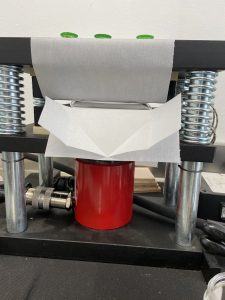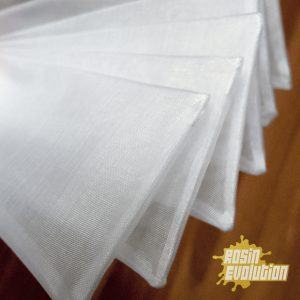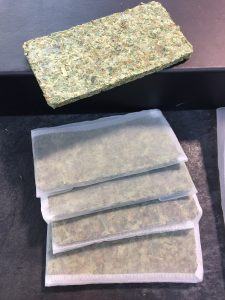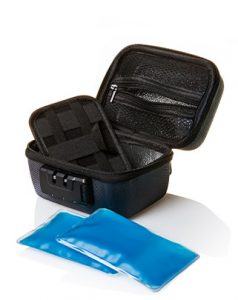
Manual Hydraulic Press
Rosin is one of the most fashionable extracts nowadays, since it is achieved by directly pressing the flowers or the "hash" by applying pressure and temperature. It is the cleanest and fastest method to obtain a high quality concentrate of cannabis oil. The result is the mixture of all the trichome heads in a mass with a very sticky texture and yellowish to amber tones, with a very high concentration of cannabinoids, terpenoids and flavonoids. It should be said that Rosin is an extract that does not deceive, it doesn't enhance the material, it just concentrates it. If the flowers you want to use are of poor quality and do not smell good, the result will be an extraction at the same level, more concentrated, but the same quality. If our base material is fresh the result will be clear and if it is old it will be dark. Everything will depend on the material you are willing to process.
Processes and material
The process is the same as that of squeezing a fruit to extract the juice. In this case we extract the content of the trichomes, which are solid at room temperature; That is why we need enough temperature to melt the essential oils that they contain, which are forced out through the filter by pressure. For this we are going to use the famous “tea-bags” or bags for rosin to introduce the content and high-quality baking paper, where the rosin will stick and we can collect it without loss. We must cut out enough baking paper so that the bag is enclosed in the middle of the papers, so that the extract does not come out at any of the 4 ends, that is, we will give a margin of at least 3 cm. on each side of the bag. Everything will depend on the material that we are going to press.
Bags for rosin or "tea-bags"

Rosin Tea Bag
There are already several brands on the market that have specialized and custom bags / filters for use in rosin presses. There are different micron ratings, and depending on the material that we are going to press, it is convenient to use one or the other so that the extraction is clean of vegetable mass or residues such as dust. The temperature used is very important for the preservation of terpenes and flavonoids, which cause aroma and flavor. We know that some of the terpenes volatilize at room temperature, so at higher temperatures or longer exposure time to them, the more acute will be the loss of these valuable trichome components, and the quality of the rosin will be affected. The texture of the rosin will also vary depending on the state of the trichome, humidity, oxidation ... A fresh plant with 10 days from cutting or less tends to give a more liquid return and difficult to manipulate, but with a high concentration of all terpenes, and as some of these more solvent terpenes evaporate over the days, the oil begins to have more consistency. The concentration of Canabinoids is also very important, since it has been proven that the high concentrations of CBD also provide this always oily texture and difficult to handle. If we start from a drier or cured trichome, the resulting rosin is usually a darker mass that can be manipulated with the hands at room temperature, and in some cases it can be hard until it can break as a crystal, also called a "shatter" texture. This type of texture is not the most fragrant at room temperature, it needs to be heated to evaporate the terpenes. It is also possible to achieve it by pressing at high temperatures (+ (80 · C)
Hash Rosin
What bags do I use?
To make bubblehash rosin (made with water and ice) or dry-sift (dry screening), it is best to use filters with the lowest possible micron level, in order to avoid any impurities that dirty our rosin. Currently 25 microns are used, since it is understood that no plant debris or dust will pass that filter, but there are also up to 15 microns.
What temperature is optimal?
The temperature to be used is also the lowest possible, being able to start extracting from 35 · C (the highest quality materials) up to a maximum of 75 · C if what you are looking for is quantity and not quality. The minimum temperature is used to preserve as much as possible all the terpenes and the lighter color of our rosin, since some terpenes volatilize at those degrees, and at higher temperatures more aroma loss. The texture will also vary at higher temperatures, probably due to this evaporation of the more solvent terpenes.
Steps to follow
When pressing hash, we want to keep the temperature as low as possible, but increase the pressing time. In this way, they will not degrade the terpenes at too high a temperature, still obtaining good yields due to the longer pressing time. The pressure that we must exert is also the minimum (the minimum pressure is very relative, because it does not even begin to mark the pressure gauge, it is the right pressure so that the bag is fixed and does not move, without crushing it) From my own experience, we would allow the bag to preheat with the minimum pressure for at least 20 seconds (if it is of the highest quality) up to 60 seconds (of less quality). This is done with the intention of melting the contents of the bag and allowing it to escape through the filter. Once preheated, we exert pressure very slowly until we begin to see how the bag begins to get wet, here we should stop applying pressure and wait a few seconds for the oil to start to come out. At this point, we recommend applying pressure as you "spit" the rosin, very slowly and progressively. A very rapid increase in pressure can cause the bag to explode ("Blow-out") and part of the content that was under pressure to come out, mixing with our rosin. That is why it is always advisable to press slowly, testing and adjusting with each material that is pressed. When most of the content has come out, you can press until you reach 700 Psi to squeeze the bag to the maximum without breaking it.
Flower Rosin or Rosin de flores
Flower or bud Rosin is achieved with the same process as Hash Rosin but using different parameters of temperature, pressure, times and humidity.

Tea Bags with pre-press
What bags do I use?
First of all, the micron rating we use for bags is different. We could use 160 or 120 micron bags without the problem of dirtying our extraction with vegetable debris, but if the material is quite dry or crumbled, it would be advisable to serve 70 or 90 micron bags. For better performance it is better to introduce the grass into the bags as evenly as possible, that there are no gaps or empty spaces inside the bag. We must remember that the bag will never be completely filled. We will always leave 1 or 2 centimeters of margin to be able to close it by folding it by the closure, so that when pressing nothing can come out of the material and mix with our extraction. It is also advisable to pre-press the material when it is in the bag to achieve that uniformity. In the market there are already for sale metal molds of the size of the bags to speed up this process, but we could do it with any other tool that allows us to exert pressure. Another system would be to pre-press the bags prepared in the same rosin press without temperature.
What temperature is optimal?
If we have a very fresh material, harvested less than 8 or 10 days ago, it is advisable to go from less to more, that is, to start with a first pressing to extract the highest quality at the lowest temperature. Later we could make more pressing of that same bag changing the paper and increasing pressure, time and / or temperature. The first pressing we recommend doing it between 65 · and 70 · C, reaching a pressure of 200 BAR or 3000 Psi for 1 minute or 1:30 minutes, and adjusting from the result. In the second we can raise the temperature between 75 ° or 82 ° C and press until we reach 300 - 400 BAR / 4200 - 4800 Psi (depending on how resistant your baking paper and bag are, the higher pressure we could break them) with the intention of finish squeezing the bag as much as possible. We will have it between 1 and 5 minutes, all depending on each material and the result that is sought. In this way we can separate the different qualities of the same material, and if it is not necessary, we can press the material directly at 80-82 · C and leave it until it stops “spitting”
The best humidity for pressing grass
Humidity also plays a bigger role than we think. After the quality of the material, temperature and pressure, relative humidity is the other factor to take into account to have all the return. Too dry material wants moisture, so it absorbs a lot of rosin before it comes out. This results in much lower returns than you should be getting. · The ideal relative humidity for the extraction of rosin from grass is 55% to 62%. These parameters will be different for each type and variety of input material. You will have to adjust and adjust, until you find the sweet spot. Therefore, there cannot be an exact value for any of the factors. But we give you a good starting point to get closer to the maximum performance / quality.
How to keep it?
 Ripper Cold Case
Ripper Cold Case
The best way to keep any extraction in its presence and initial texture is to preserve it from light, oxygen and temperature. It is usually kept in an airtight container and in the fridge. This is the way in which the essential oils of the plant deteriorate the least (cannabinoids, terpenes and flavonoids for the most part). The storage time can be unlimited if the rosin does not contain any impurities and is kept in the indicated conditions. But it can probably change its state or color over the months, it all depends on all the differential factors of each crop and extraction. There is no rosin equal to another. For transportation we recommend Ripper Cold Case that you will keep all day our extractions in perfect condition. -Do not manipulate directly with your hands, although it is possible due to its texture. The imperceptible fat on our skin contaminates the Rosin and adds substances that can vary its consistency and quality, until it spoils it. -When we are going to press grass that possibly contains seeds, it is very important that there are none left inside the bag. We have to make sure our weed is seed free. The oils they contain such as omega3 will also be extracted, mixing with our rosin and making it infumable. -It is convenient to use a high quality greaseproof paper. Some of low quality can contaminate our Rosin with remains of fibers that come off when handling it. -We should change the baking paper for each bag, since by exerting so much pressure the paper loses consistency and could crack or break, which would make it difficult to collect it easily and cause considerable losses. It would also contaminate the rosin with fiber debris. -The pressed bags or also called "chips" with the dry material inside, still contain a high concentration of cannabinoids. There are some remains of rosin that are impossible to extract with this method. That is why they are used to make cannabis cuisine or creams for use on the skin (topically).
